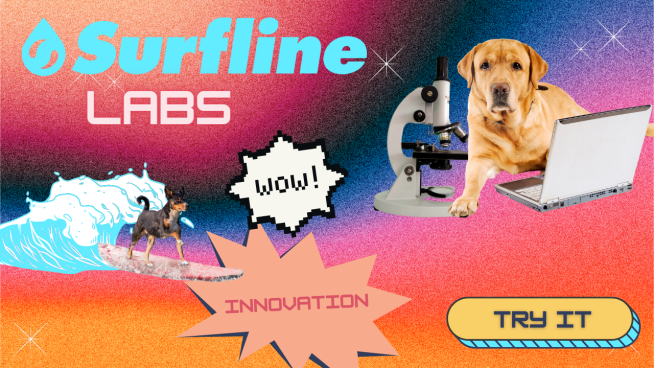What'sNew
Check here for all the latest Surfline updates.
Spectra
Oct 16, 2023 / Back to top

With some swells, there’s more than meets the eye.
New from Surfline Labs: swell spectra graphs give you a deeper insight into where energy is concentrated.
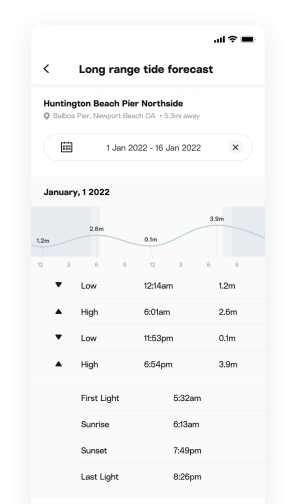
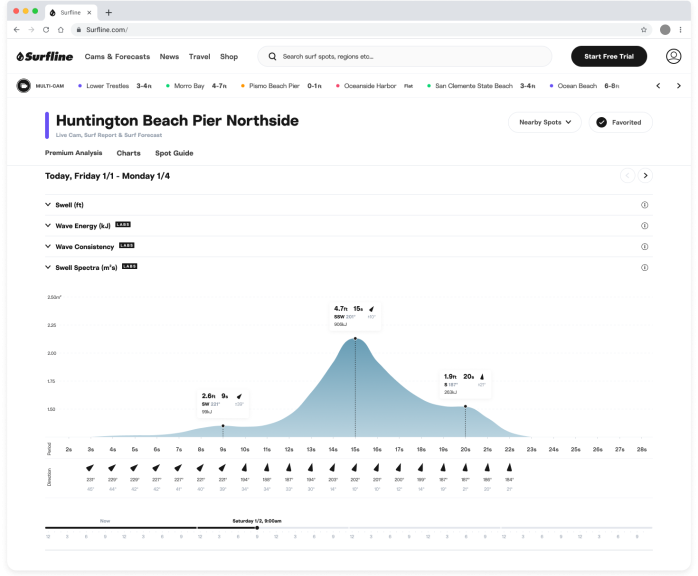
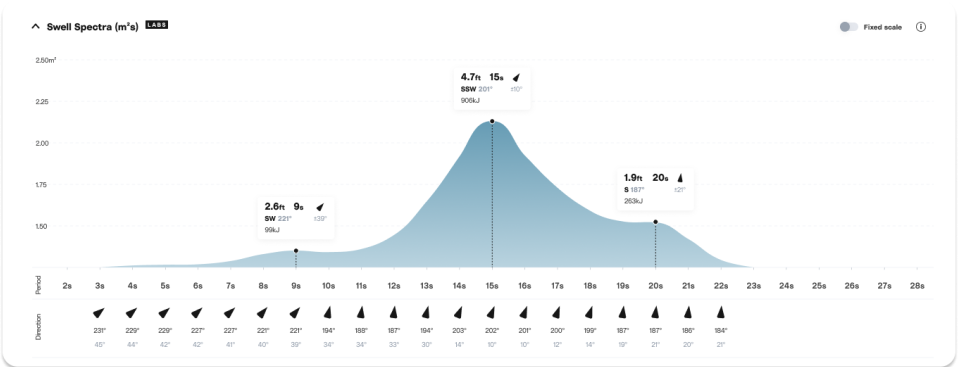
Every wave in a swell breaks differently. Waves within one swell range in size and period, so when we say, “six foot at 13 seconds,” we mean that the average height of the largest third of waves is six foot, and the most energetic waves are around 13 seconds apart.
You might be used to reading the Surfline swell graphs to understand where wave energy is concentrated, but we all know from experience that two days (or even two hours) with six foot at 13 second swells can result in a different experience in the water.
Swell spectra shows you not just the averages (the peaks on the spectra graph), but where all the energy is distributed in a swell. For MSW fans, this graph should look and feel familiar.
How to use swell spectra to understand surf conditions.
Concentrated spectrum
In this example, nearly all of the energy is concentrated across a small number of wave periods, so this is a very concentrated spectrum. Concentrated energy is usually associated with less consistent swell (i.e. longer breaks between sets of waves), so you can expect there to be more waves in a set, and for the waves to be more organized and uniform in terms of shape and size.
Wider spectrum
Above, the energy is distributed across many wave periods, creating a wider spectrum. The peak of the spectrum is still ‘sharp’, so you’ll observe a good amount swell associated with the 16-second wave period. But overall, the wider distribution means both shorter period and longer period waves will be in the mix, leading to conditions that will likely be a little bit mixed up and disorganized, but consistent. This is a great example how the ‘peak’ we list elsewhere may not always give the whole picture.
Missing swells
Sometimes, the wave model has difficultly identifying the separate swells in the wave spectrum. With this example, the wave model has only identified and listed one swell, because there aren’t clear individual peaks. The spectrum provides the full picture, which shows a significant energy in the shorter periods, which will likely create mixed up and choppy surf.
In this situation, a small change in the energy at seven seconds could cause the ‘peak’ to jump down from 12 seconds. You see this happen quite a lot in the forecast, and the swell spectra can help explain that the surf doesn’t necessarily change as much as expected in that scenario.
Graph key
Spectral wave density*: y-axis
Wave periods: x-axis
Mean wave direction at each period: arrow and degrees in black
Mean spread of direction: degrees in gray
Partition wave height: see tooltips at peaks
*Spectral wave density represents the distribution of wave energy across the different periods.
Why did we build this?
Swell spectra is part of our effort to give you everything you need to get involved with the forecasting process, so you can dig a little deeper and know exactly how swells will be affecting the spots you want to surf. Many Surfline members want deeper access to the data behind our surf height predictions so they can make their own determinations about surf conditions at that spot—or nearby secret spots.
Where can I find it?
Find this graph at the bottom of every spot page under “Swell Spectra”. Available now on web to Premium and Forecast members, coming soon to iOS and Android.
Everything else you need to know.
As a Surfline Labs feature, swell spectra graphs are still in their early phases, and the UI and data models behind it may continue to evolve as we test it out and receive feedback from members. Feel free to reach out with your thoughts at feedback@surfline.com.
Wave Consistency

How’s your wave count?
New from Surfline Labs: Our new Wave Consistency metric predicts just how long it might take to get a couple of fun ones.
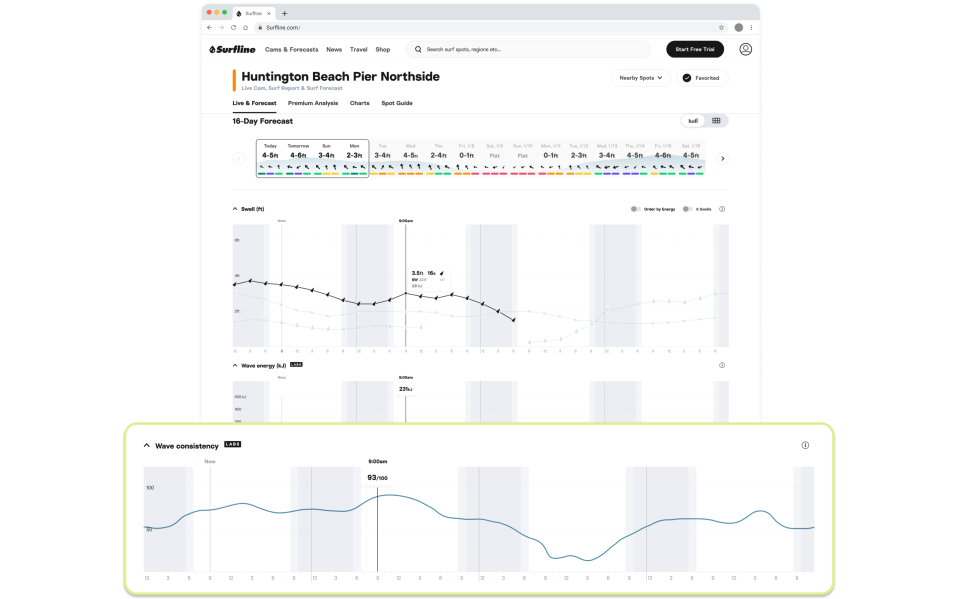

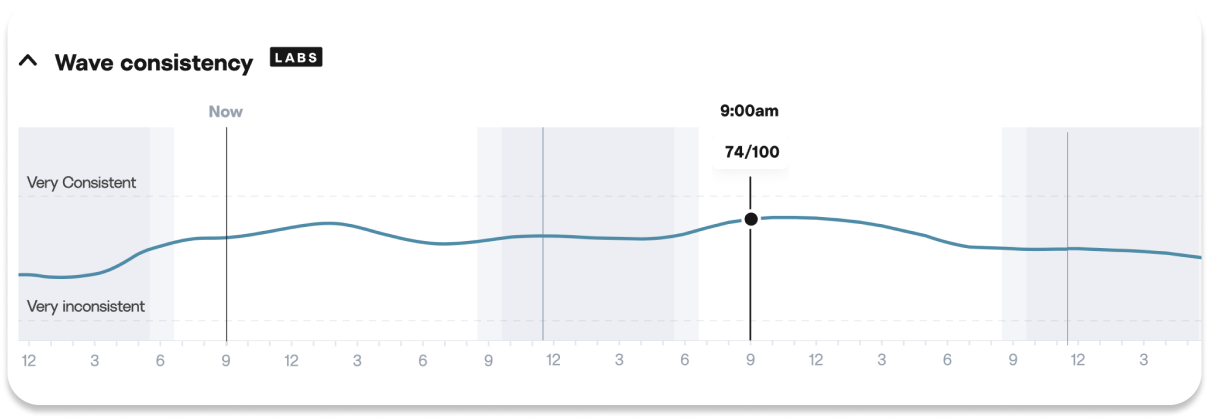
Will it be pumping or lully? Wave Consistency will tell you.
We’ve all experienced those sessions where it feels like there are more than enough waves to go around, as well as those days where you’re waiting for ages between sets.
We’ve developed a new metric, Wave Consistency, to predict how regular the set waves are at a specific spot to give you an idea ahead of time.
How should I use it?
Consistency helps you to make the most out of a session—choosing the right spot, picking the right board, or adjusting your spot in the lineup—by giving you a sense of how consistent set waves will be.
The higher the number, the more sets and waves you can expect. It can also help you determine how intense the paddle out will be and whether you’ll be able to take advantage of lulls to sneak out the back.
How does it work? What’s behind the metric?
Wave Consistency predicts the frequency of waves every hour, at every spot, on a scale out of 100. For example, if the score is 20/100 it might feel a bit slow or lully. If the score is 80/100, your chances of riding more waves (or copping more sets on the head) are higher.
We’re putting a value on how “setty” the surf will be and how many waves there will be in a set. We derive this from our wave model, LOTUS, by predicting how many waves will exceed a certain wave height threshold for that spot. The higher the score, the more often that threshold has been exceeded (more sets).
The scale is standardized across spots, so you can compare Wave Consistency at your favorite breaks, along with swell height, wind, and tide before you head out.
Where can I find it?
Find this metric at the bottom of every spot page under “Wave Consistency”. Available now to Premium and Forecast members.
Everything else you need to know.
As a Surfline Labs feature, Wave Consistency is still in its early phases, and the UI and data models behind it may continue to evolve as we test it out and receive feedback from members. Feel free to reach out with your thoughts at feedback@surfline.com.
FAQ
Can you have a 4ft surf height with a low and high Wave Consistency number?
Yep, the Wave Consistency score can vary even if the forecasted surf height remains the same.
You’re predicting a high wave consistency but it’s huge and not surfable - what’s the deal?
The Wave Consistency metric predicts the frequency of the set waves and is not considering the quality of them. Our forecasts already provide information on height and quality.
It’s generally true that long-travelled swell of the sort surfers get excited about is often less consistent than short-period wind swells.
Why is the Wave Consistency score almost 0 but it’s not forecasted to be flat?
The score focuses on predicting the occurrence of set waves rather than all waves. This means that even when the forecast isn't entirely flat, the score may drop if these key set waves are few and far between – particularly in scenarios involving very short-period wind swells.
Wave Energy

Aug 9, 2023 / Back to top
Not all waves are created equal.
Wave Energy gives you more insight into how the waves will feel at your spot.

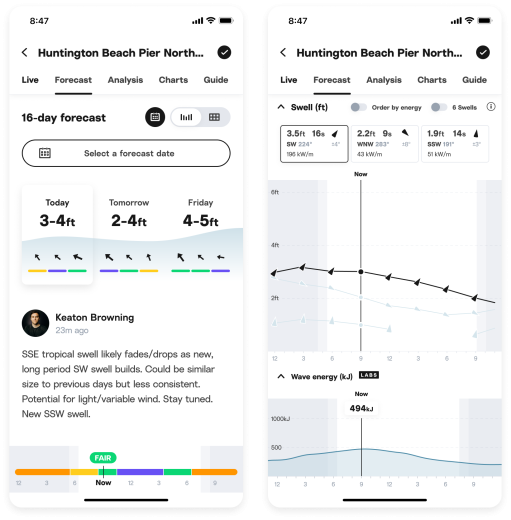
We are excited to have recently launched one of our most requested features of all time: Wave Energy. This new metric will help you fine-tune your surfing decisions by giving you more information on the swells you’re checking out and how the waves will feel at your spot.
What is Wave Energy?
The height and period of a wave determine the energy it carries—larger, longer-period waves are more energetic. Higher energy waves generally create bigger surf, but they can also change the way waves break. While the depth of the water, the tide, and the sandbars or reef will change how powerful the surf feels, the energy will also have an impact on this. Higher energy waves generally feel more powerful and break more forcefully (more push).
We show you the energy of the swell as it's likely to be felt at your spot. We do this by taking into account how much of the swell we think will arrive on your local beach as it moves from deeper water.
How should I use it?
Wave Energy can give you both a guide to how waves will feel at your spot and also an aid to understanding how swell height and period contribute to creating surf at your local beach.
If you are already an experienced forecaster we think you'll find Wave Energy a great 'at-a-glance' guide to spotting swells that matter to you. If you're new to using our more advanced data, Wave Energy is a stepping stone to starting to use other swell information to really understand how different ocean conditions contribute to the waves you like to surf.
In any case, as with everything we offer, we suggest you check the forecast and get in the water yourself—the easiest and most enjoyable way to learn how to use this data is by correlating it to your direct experience.
Everything else you need to know.
Wave Energy is one of our first Surfline Labs features. This means it’s experimental, and the user interface and data models behind it are works in progress. Learn more about Labs below. We’d love to hear your feedback here.
Wave Energy is available to Premium and Forecast members.
About
July 17, 2023 / Back to top

What is Labs?
Surfline Labs gives you a window into the development of the latest features we’re bringing to Surfline, and the opportunity to help them reach their full potential. It’s like stepping into a shaping bay, giving the shaper feedback as a new surfboard model comes to life, testing it out, and making notes so the shaper can try a new iteration, until you get the final result—a perfect board.

What to expect from Lab features.
Labs features are experimental and the data models behind them are works in progress, so set your expectations accordingly. They will often be available for a limited time, and we may polish and ship them, or decide they don’t make the cut and remove them. Some features will be available to all, and others will only available to subscribers.
Feedback encouraged.
Most importantly, we look forward to your feedback. You can let us know your thoughts at feedback@surfline.com. See you out there!
